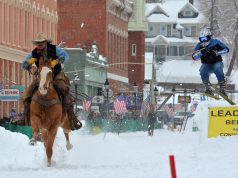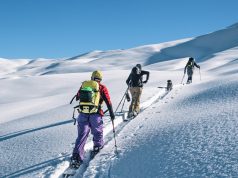
When Sarah Hassell climbed her first 14,000-foot peak in Colorado, she felt “an overwhelming sense of gratitude.” It wasn’t due to the view, or the stable weather that allowed her to summit, or even the fact that the friends she climbed the peak with were there to accompany her to the top. It was because she made it up there — higher than she’d ever climbed — due to a stranger’s heart.
Hassell had never climbed a peak before. In fact, she didn’t do much at all. When you have a heart that’s failing, she says, “one of the things that is terrifying is that I had a very limited number of heartbeats left. I didn’t want to waste them doing physical activity.”
That equation was dramatically changed when she received a heart transplant in 2006.
“It took a solid year to recover from surgery,” Hassell says. “But I was able to return to my life the way I was living before, with a lot of energy. But the one thing I could never do before was things at altitude. I would never be able to climb a 14er. This is a complete change, and it’s an ultimate statement, it really is the ultimate thing.”
As part of the Colorado-based No Barriers What’s Your Everest? climb on Saturday, June 1, Hassell will be attempting her fifth 14er as she joins a diverse group of climbers — from novice to expert — on an ascent of Front Range classic Grays Peak (14,270 feet).
The climb will raise money for No Barriers, an organization that provides transformative experiences to empower people to embrace a no-limits mindset and discover the potential that lies within themselves and the world.
Hassell and her husband atop Mt. Elbert, Colorado’s highest 14er | Photo courtesy of Sarah Hassell
Created in 2005, No Barriers operates on the assumption that each person, regardless of age, state of mind or physical condition, has a thirst for adventure and a hope for the future that is worthy of igniting. The organization started with a summit featuring innovative technologies that enabled people with and without disabilities to envision a full and active life. Later, the group’s mission expanded to include a partnership with Soldiers to Summits and an online educational resource library.
Put simply, No Barriers seeks to get people with disabilities or other issues to break free of what they thought was possible, think outside the box and push themselves and their life into a space that they never thought they’d reach. The organization takes a multi-faceted approach, from assisting with paying for prosthetics as well as providing expertise and funding for bigger projects, such as Antarctic expeditions undertaken by disabled veterans.
They’ve supported individual efforts, such as congenital amputee Kyle Maynard’s successful Mt. Kilimanjaro summit attempt. And, locally, they host and organize the What’s Your Everest? climb in Colorado, an opportunity to connect the No Barriers and Soldiers to Summits communities, to raise support and funds for the organizations and, for those like Hassell, to push themselves beyond what they ever dreamed possible.
This year’s attempt on Grays is, according to No Barrier’s Katie Watkins, the opportunity to “harness the power of our adversary, connect with others and hear their shared stories and an easy way to immerse yourself in the No Barriers community.”
Watkins admits that she doesn’t have an illustrious background as a mountain climber. “The first time I did it,” she says, “I got to climb with the Soldiers to Summits program. It was a reminder that this person can do this who doesn’t have a leg, and they can go on and live a life that’s pretty full of adventure and fulfilling.”
The Grays trip has a variety of people participating. Along with Hassell, Watkins says there will be some disabled veterans from the Soldiers to Summits program, some young adults and a woman who is blind.
“It will be her first climbing experience,” says Watkins. “And the goal for her is to make it to the summit.”
It was also Jana Zunich’s goal to make it to the summit the first time she attempted a 14er as part of a group with Soldiers to Summits participating in last year’s What’s Your Everest?
“I made it to 12,000 feet,” she says of an effort that started due to her husband turning 60 and wanting to make some positive changes to his lifestyle.
“He said, ‘I’m turning 60 and I need to have a healthier lifestyle and get into shape,” Zunich says, and laughs. Zunich’s husband, Jim McDonald, is a veteran, having served as a contractor in the Middle East, so, she says, climbing with Soldiers to Summits and No Barriers was a natural choice.
“It’s both a mental and physical challenge,” she says of tackling Colorado’s highest peaks. “But climbing a mountain is so much more rewarding when you’re doing it for a reason.”
Obviously, that reason is to support disabled veterans though the Soldiers to Summit program as well as the other projects that No Barriers is involved with. But more than the fundraising that’s involved in the What’s Your Everest? climb, Zunich says that the personal involvement and commitment of those who participate in the physical challenge of the climb sends an invaluable message to the disabled veterans who are taking on the mountain themselves.
“In the military, the guys form a team and have to work out things together, make joint decisions and act as part of a group,” says Zunich. “When you leave the military, that isn’t operation standard, and climbing a 14er allows them to have to use some of the same skill sets, like having to make decisions together and to depend upon the team.
“Climbing a mountain with these veterans and being part of that team tells these guys that they are important to us,” she adds. “That their well-being matters, that their recovery matters, and it’s much more fun to climb a mountain for a cause.”
Sadly, Zunich will be on injured reserve this year with a broken foot, and will support the attempt on Grays from base camp.
“I’m totally bummed because I trained really hard!” she laughs, and then quickly adds that next year, once she’s recovered, she’ll be ready to give a 14er another shot when What’s Your Everest? tackles the next mountain.
It’s this positive mindset that resonates though all of those who’ve participated in one of the What’s Your Everest? climbs.
Hassell and her husband at the saddle on Mt. Democrat | Photo courtesy of Sarah Hassell
“The only thing you can do is start doing it,” says Hassell. “One foot in front of another. You can’t think too hard about how big the obstacle is. One step at a time sounds trite, but that’s how you get started.”
“I’m going to try to do all 54 14ers, if I can swing it,” she adds. “It’s hard work, but that’s my lifetime goal. … I’m going to do one mountain at a time. Go slow, breathe deep, that’s how I do it.”
Respond: [email protected]














